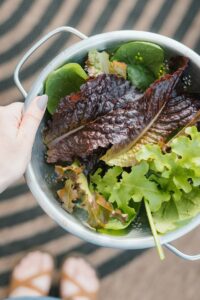Are you tired of buying expensive, pesticide-laden vegetables from the grocery store? Have you ever dreamed of walking through your lush vegetable garden, plucking fresh and ripe produce straight from the vine? If so, you’re in luck! This article will explore the wonderful world of growing your vegetable garden. From choosing the right seeds to nurturing your plants through each growth stage, we will give you all the tips and tricks you need to turn your backyard into a flourishing oasis of delicious and nutritious vegetables. So please wear your gardening gloves and prepare to embark on a green-fingered adventure with us!
Choosing the Right Location for Your Garden
Consider sunlight exposure
When selecting a location for your garden, consider the amount of sunlight it will receive. Most vegetables require at least 6 to 8 hours of total sun exposure daily to thrive. Therefore, choose an area in your yard that receives ample sunlight throughout the day. Remember that buildings, trees, and other structures can cast shadows and reduce the amount of the sun reaching your plants. By selecting a location with sufficient sunlight, you are setting your garden up for success.
Evaluate soil conditions
The condition of your soil plays a vital role in determining the health and productivity of your vegetable garden. Before planting, it is crucial to evaluate the soil’s texture and fertility. Sandy soil drains quickly, while clay soil retains water and may require additional amendments for proper drainage. Conduct a soil test to determine its pH level and nutrient content. This will help you understand if any adjustments or amendments are necessary to create an optimal plant-growing environment.
Ensure proper drainage
In addition to evaluating soil conditions, ensuring proper drainage is crucial for the overall health of your vegetable garden. Excessive water retention can lead to root rot and other issues. If your soil has poor drainage, consider implementing raised beds or adding organic matter to improve it. Proper drainage helps prevent waterlogged soil, allowing the roots to access oxygen and nutrients more effectively.
Account for space requirements
Different vegetable plants have different space requirements. Some plants, like tomatoes and cucumbers, require more room to grow and spread out, while others, like lettuce and radishes, can be grown more closely together. Consider the final size of each vegetable plant when planning your garden layout to avoid overcrowding. Providing enough space for each vegetable to thrive will contribute to healthier plants and a higher yield in the long run.
Deciding What to Plant
Assess your needs and preferences.
Before deciding what vegetables to plant in your garden, take a moment to assess your needs and preferences. Consider which vegetables you and your family enjoy eating the most and any dietary restrictions or preferences. Additionally, think about the quantity of produce you would like to harvest. If you have limited space, prioritize growing vegetables that are expensive to buy or challenging to find in the local markets. Tailor your vegetable selection to match your unique needs and preferences.
Research vegetable varieties
Once you have determined your needs and preferences, it’s time to research different vegetable varieties. There are countless options available, each with its characteristics and requirements. Look for varieties that are well-suited to your climate and growing conditions. Consider factors such as disease resistance, productivity, and flavor. Reading seed catalogs and consulting with local gardening experts can provide valuable insights into the best vegetable varieties for your area.
Consider seasonal availability
While it may be tempting to plant your favorite vegetables all at once, it is essential to consider their seasonal availability. Different vegetables have specific planting windows based on your region’s climate and temperature. Some vegetables thrive in cooler temperatures, while others require warmer conditions to grow successfully. By understanding the seasonal availability of different vegetables, you can plan your planting schedule accordingly and maximize your garden’s productivity throughout the year.
Preparing the Soil
Clear the area of weeds and grass.
Before preparing your soil, clear the selected area of any weeds, grass, or other vegetation that may compete with your vegetable plants for nutrients and space. Use a garden shovel or hand trowel to remove the unwanted plants, ensuring their roots are completely removed from the soil. This initial step helps create a clean and fertile canvas for your vegetable garden.
Test soil pH and nutrient levels.
Conducting a soil test is a crucial step in preparing your soil. Testing your soil’s pH level and nutrient content provides valuable insights into its composition and helps determine the necessary amendments. Soil test kits are readily available at gardening centers or can be sent to a professional lab for more accurate results. Based on the test results, you can adjust the pH level and add nutrients to ensure your soil provides an optimal growing environment for your vegetables.
Amend soil with organic matter.
Adding organic matter to your soil effectively improves its structure, drainage, and fertility. Organic matter, such as compost, well-rotted manure, or leaf mold, enhances the soil’s moisture-holding capacity and nutrient availability. Spread a thick layer of organic matter over the topsoil and use a garden fork or tiller to mix it into the existing soil. Organic matter helps create a healthy and nutrient-rich bed for your vegetable plants.
Loosen and aerate the soil.
Before planting, it is essential to loosen and aerate the soil. This allows the roots to penetrate quickly, promotes drainage, and facilitates nutrient absorption. Use a garden fork or tiller to gently loosen the soil to a depth of 6 to 8 inches. Avoid compacting the soil by over-tilling it, which can lead to poor drainage and hinder root growth. By properly preparing the soil, you are laying the foundation for a thriving vegetable garden.
Planning and Designing Your Garden
Draw a garden layout.
Creating a garden layout plan helps visualize the placement of your vegetable plants and ensures optimal use of space. Consider the size and shape of your garden bed or beds and any existing structures or features in your garden. Use graph paper or specialized garden planning software to sketch out the layout. Remember the different space requirements and plant heights of your chosen vegetable varieties. A well-thought-out garden layout plan sets the stage for a productive and aesthetically pleasing vegetable garden.
Determine bed sizes and paths.
When planning your garden design, please consider the size of your beds and the paths between them. Too wide beds can be challenging to reach the center, making it difficult to tend to the plants in the middle. Conversely, beds that are too narrow may restrict root growth and limit plant development. Plan for wide paths to navigate while carrying tools or harvesting vegetables comfortably. Designing appropriate bed sizes and paths ensures easy access and efficient maintenance for your vegetable garden.
Consider companion planting
Companion planting involves strategically planting compatible vegetables to enhance growth, repel pests, and maximize space utilization. Some plants have beneficial relationships when planted together, such as tomatoes and basil or carrots and onions. Conversely, certain plants should not be grown together due to incompatible growth habits or susceptibility to shared pests or diseases. Research different companion planting combinations to create a harmonious and mutually beneficial ecosystem in your vegetable garden.
Allocate space for each vegetable.
Allocate specific areas or beds for each variety to ensure each vegetable has enough space to grow and thrive. Follow the spacing recommendations on the seed packets or plant labels, as they guide the appropriate distance between each plant. Overcrowding can lead to nutrient competition, increased pest and disease susceptibility, and reduced yields. By giving each vegetable its designated space, you promote optimal growth and maximize your garden’s productivity.
Starting from Seeds
Choose high-quality seeds
When starting your vegetable garden from seeds, it is crucial to choose high-quality seeds. Look for reputable seed suppliers or choose hybrid varieties known for their vigor and disease resistance. Read the seed packets or catalog descriptions to understand each vegetable variety’s specific requirements and growing conditions. Selecting reliable and high-quality seeds sets the stage for healthy and productive plants.
Indoor seed starting
Indoor seed starting is a cost-effective method to get a head start on your vegetable garden. It allows you to control the temperature, light, and moisture conditions for optimal germination and seedling growth. Fill small containers or seed trays with a suitable seed starting mix and plant the seeds according to the instructions. Place the containers in a warm and well-lit area, such as near a south-facing window or under a grow light. Regularly water and monitor the seedlings’ progress until they are ready for transplanting outdoors.
Transplanting seedlings into the garden
Once your seedlings have grown to a suitable size, it’s time to transplant them into your garden. Choose a day when the weather conditions are favorable and the risk of frost has passed. Before transplanting, harden off the seedlings by gradually exposing them to outdoor conditions for 7 to 10 days. Dig a hole in the prepared soil, gently remove the seedling from its container, and place it in the hole. Pat the soil around the seedling, ensuring it is firmly in place. Water the transplanted seedlings thoroughly to help them establish in their new environment.
Planting from Seedlings
Purchase healthy seedlings
If you prefer to skip the seed-starting process, you can purchase healthy seedlings from local nurseries or garden centers. Look for seedlings with lush foliage, well-developed roots, and no signs of disease or pests. Healthy seedlings are more likely to establish quickly and produce a bountiful harvest. Transport the seedlings home carefully, protecting them from extreme temperatures or damage during transit.
Prepare the soil and plant seedlings properly.
Before planting the seedlings, ensure that the soil is adequately prepared. Follow the soil preparation steps mentioned earlier, such as clearing the area of weeds, testing the soil pH and nutrient levels, amending the soil with organic matter, and loosening it to promote aeration. Dig holes in the soil to accommodate the size of each seedling’s root system. Gently remove the seedlings from their containers carefully not to damage the roots. Place the seedlings in the prepared holes, ensuring the soil level matches the depth of the containers. Firmly press the soil around the base of each seedling and water thoroughly.
Providing Adequate Watering
Establish a watering routine.
Water is vital for the health and growth of your vegetable garden. Establishing a regular watering routine is crucial, especially during dry periods. Soak the soil thoroughly, allowing the water to penetrate the plant roots. Avoid shallow watering as this promotes shallow root growth and limits the plant’s ability to access deep soil moisture. Consistency is key, so aim to water simultaneously each day or as needed, depending on weather conditions and soil moisture levels.
Monitor soil moisture levels.
It is important to monitor the soil moisture levels regularly to avoid overwatering or underwatering your plants. Use your finger or a moisture meter to check the moisture content of the soil. If the top inch of soil feels dry, it is a sign that your plants require watering. On the other hand, if the soil feels excessively wet or muddy, it may indicate overwatering. By closely monitoring and adjusting your watering routine based on the soil moisture levels, you can avoid detrimental effects and promote healthy plant growth.
Avoid overwatering
While adequate water is essential, overwatering can be just as harmful as underwatering. Excessive moisture in the soil can lead to root rot, fungal diseases, and poor plant growth. Avoid unnecessarily frequent watering or prolonged periods of wet soil. Aim for moist, well-drained soil rather than constantly saturated conditions. Allow the soil to dry slightly between watering sessions to encourage deep and robust root growth.
Consider the use of irrigation systems.
Consider implementing irrigation systems in your vegetable garden to streamline the watering process and ensure efficient water distribution. Drip irrigation or soaker hoses deliver water directly to the soil at the base of the plants, minimizing water loss through evaporation. Additionally, timed irrigation systems can automatically water your garden at pre-determined intervals, reducing the need for manual watering. These systems are especially beneficial for more extensive gardens or when regular watering is not feasible.
Caring for Your Vegetable Garden
Implement a regular weeding routine.
Weeds can quickly establish themselves in your vegetable garden and compete with your plants for resources. Implementing a regular weeding routine is essential to keep your garden beds free from unwanted vegetation. Use a garden hoe or hand tools to carefully remove weeds, ensuring that you extract their entire root systems. Regular weeding promotes better plant growth and reduces the likelihood of pests and diseases finding a home in your garden.
Apply organic fertilizers
Consider applying organic fertilizers to ensure your vegetable plants receive the necessary nutrients for healthy growth. Organic options, such as compost, well-rotted manure, or fish emulsion, release nutrients gradually into the soil, providing a steady supply of essential elements. Follow the fertilizer package instructions for proper application rates and timing. Applying organic fertilizers regularly helps replenish soil nutrients and supports robust plant growth without the risk of chemical buildup.
Protect plants from pests and diseases.
Pests and diseases can threaten the health and productivity of your vegetable garden. To protect your plants, regularly inspect them for signs of pests or diseases, such as chewed leaves, discoloration, or wilting. Use organic pest control methods, such as handpicking pests, applying neem oil, or using natural predators like ladybugs. Encourage beneficial insects, like bees and butterflies, by planting flowers nearby and avoiding using harmful chemical pesticides. Promptly addressing pest and disease issues helps maintain a thriving and pest-free vegetable garden.
Stake or support tall-growing vegetables
Some vegetable varieties, such as tomatoes, beans, and cucumbers, require support as they grow taller. Staking or providing trellises for these plants helps prevent them from bending or breaking under their weight. Install sturdy stakes or trellises during planting or shortly after to avoid damaging the plant’s root system. Tie the plant gently to the support structure as it grows, ensuring it has room to breathe and expand. Proper support encourages vertical growth, minimizes disease susceptibility, and makes harvesting more manageable.
Harvesting Your Vegetables
Determine the right time to harvest each vegetable.
To enjoy the best flavor, texture, and nutritional value, it is crucial to determine the right time to harvest each vegetable. Different vegetables have different indicators of ripeness, such as color, size, and firmness. Consult seed packets, gardening guides, or reputable online sources to understand the specific harvesting cues for your chosen vegetables. Harvesting at the optimal time ensures peak flavor and quality.
Use proper harvesting techniques.
When harvesting your vegetables, use proper techniques to minimize plant damage and maximize the harvested produce’s quality. Use clean gardening tools, such as scissors or shears, to cut or gently twist the vegetables from the plant. Avoid excessive pulling or tugging, damaging the plant, or disturbing the surrounding roots. Handle the harvested vegetables with care to prevent bruising or other injuries. Proper harvesting techniques ensure the longevity and freshness of your homegrown produce.
Storing and Preserving the Harvest
Clean and prepare vegetables for storage
After harvesting your vegetables, cleaning and preparing them for storage is essential. Gently wash the vegetables under cool running water to remove any visible soil or debris. Pat them dry with a clean towel or allow them to air dry before storing. Trim off any damaged or wilted parts to maintain the quality of the remaining produce. Properly cleaning and preparing your vegetables ensures they stay fresh and free from contaminants during storage.
Utilize proper storage methods.
To ensure the longevity of your harvested vegetables, it is crucial to utilize proper storage methods. Some vegetables, such as root crops like carrots and potatoes, prefer cool and dark conditions, while others, like leafy greens, require refrigeration to maintain freshness. Store vegetables in breathable containers, such as mesh or perforated plastic bags, to allow air circulation and prevent moisture buildup. Avoid storing vegetables near fruits that release ethylene gas, which can accelerate ripening and spoilage. Understanding the specific storage requirements of each vegetable helps prolong their shelf life.
Explore different preservation techniques.
Consider exploring different preservation techniques to make the most of your harvest and enjoy your vegetables even beyond their growing season. Freezing, canning, pickling, and dehydrating are all viable methods to extend the shelf life of your harvested vegetables. Each preservation method offers unique benefits and flavors, allowing you to enjoy your homegrown produce throughout the year. Experiment with different techniques and recipes to find the best preservation method for your preferences and needs.
By following these guidelines and dedicating time and effort to your vegetable garden, you can enjoy the satisfaction of growing your food and reaping the rewards of your hard work. Whether you have a small plot or a spacious backyard, a well-planned and well-maintained vegetable garden can provide fresh, nutritious produce and a deeper connection to nature. Happy gardening!



